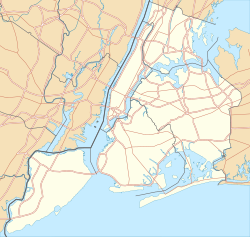Ridgewood, Queens
| Ridgewood | |
|---|---|
| Neighborhood of Queens | |

Myrtle Avenue's Business Improvement District runs from Wyckoff Avenue to Fresh Pond Road in Ridgewood where the elevated Bay Ridge Branch of the LIRR crosses over Myrtle Avenue and serves as a border between Ridgewood and the neighboring "lower" portion of Glendale.
|
|
| Location of Ridgewood in Queens, New York | |
| Coordinates: 40°42′00″N 73°54′20″W / 40.70000°N 73.90556°WCoordinates: 40°42′00″N 73°54′20″W / 40.70000°N 73.90556°W | |
| Country |
|
| State |
|
| County | Queens |
| Population (2010) | |
| • Total | 69,317 |
| Ethnicity | |
| • Hispanic / Latino | 49.0% |
| • White | 39.8% |
| • Asian | 7.7% |
| • African American | 2.0% |
| • Other | 1.5% |
| Economics | |
| • Median income | $42,049 |
| ZIP code | 11385 |
| Area code(s) | 718, 347, 917 |
Ridgewood is a neighborhood in the New York City borough of Queens. It borders the neighborhoods of Maspeth, Middle Village and Glendale, as well as the Brooklyn neighborhoods of Bushwick and East Williamsburg. Historically, the neighborhood straddled the Queens-Brooklyn boundary. The neighborhood is part of Queens Community Board 5.
Originally, Ridgewood was part of the Dutch settlement Boswijk (Bushwick) and was later incorporated into the village of Breuckelen (now Brooklyn). A legacy of this past stands today; Onderdonk House, which was erected in 1709. The house is the oldest Dutch Colonial stone house in New York City. Also located at the Onderdonk House site is Arbitration Rock, which was a marker for the disputed boundary between Bushwick and Newtown and essentially Brooklyn and Queens.
Although the area was originally farmed and settled by the Dutch during the 18th and 19th centuries, it was the secondary wave of English settlers who named it Ridgewood after the area's green and hilly terrain. The development of public transportation, from horse-drawn cars in the mid-19th century and later trolleys and elevated trains, helped to spur residential and retail development. Most of the housing stock was built between 1905 and 1915 to house German immigrants who worked in the breweries and knitting factories that straddled the Queens-Brooklyn border.
After World War I, the population expanded with an influx of Gottscheers—an ethnic German population from Slovenia who were dislocated in the aftermath of World War I—and Irish, followed soon after by Italians. In April 1934, a large, 9,000-person boycott of Nazi Germany resulted in brawls between Nazi sympathizers and Jewish Communist groups.
...
Wikipedia



